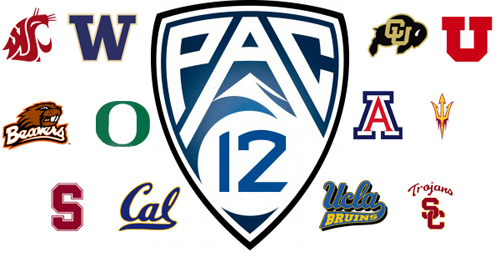By Jon Wilner
LAS VEGAS — Once again, the greatest threat to Pac-12 football is airborne, attacks the respiratory system and can shut down cities.
But unlike COVID, the likeliest source of disruption this season can been seen, smelled and tracked in real time.
“Let me show you what I have on my phone,” Pac-12 commissioner George Kliavkoff said to a recent visitor.
A few touches later, Kliavkoff’s phone screen displayed an app showing the air quality levels for locales across the conference.
Each day, he checks for smoke.
“It’s a real concern,” he said.
The pandemic could prompt the Pac-12 to cancel or postpone games. But given the high vaccination rates for players and coaches — most teams are above 90% — COVID has been dethroned, at least for the moment, as the chief threat to competition.
But the perils posed by wildfires, and the suffocating smoke that can spread for thousands of miles, are substantial.
Last fall, Pac-12 teams waited anxiously for PCR results.
This fall, it’s about AQI levels.
“It’s probably going to be pretty bad based on how things are already,’’ said John Balmes, a professor of medicine at the University of California-San Francisco and member of the California Air Resources Board.
“Until we get some rain, it’s not going to get any better. And then we get those crazy fall winds.”
Normally, winds from the Pacific Ocean blow easterly and take the smoke with them. (Salt Lake City was recently slammed with bad air from the massive Dixie Fire in Northern California.) But in the fall, the direction shifts and winds blow west off the mountains, threatening the campuses close to the coast.
“If the air quality is like it was last August, it’s going to be problematic,” Balmes said.
The intense smoke that blanketed California, Oregon and Washington for prolonged stretches late last summer didn’t cause cancellations — COVID took care of that.
But had there been no pandemic, the devastating wildfires would have caused numerous cancellations and postponements.
The day Oregon was scheduled to host Ohio State, for example, the air in Eugene was off the scale, literally.
Air quality is measured on a scale of 1 to 500.
Anything over 150 is considered unhealthy.
Over 300, and it’s hazardous.
On the day of the scheduled showdown, the AQI reading in Eugene reportedly hit 511.
The threshold that matters most for Pac-12 football this season is 200. At that level, there are too many particulates in the air and too many risks to the participants.
“During physical exertion, you breathe heavily through an open mouth,” Balmes explained. “So you’re taking in more bad air and, because you aren’t using your nose, there’s no filtration system.”
The Pac-12 has what it calls a “general guideline” for addressing issues with air quality. Because outdoor sports vary greatly in both intensity and duration — and because air quality conditions can change quickly — a one-size-fits-all approach could invite complications and confusion.
The essential elements pertaining to football are the following:
— The decision to play should be based on the AQI leading into the activity, the AQI projections over the span of the activity and the forecast for wind direction.
— Special consideration should be given to athletes with asthma or respiratory conditions.
— If the AQI is within, or expected to be within the 151-200 range (unhealthy) “for a prolonged period of time,” the schools should “consider” relocating or postponing the game.
— If the AQI is, or expected to be over 200 (very unhealthy), then: “Competition should be postponed, rescheduled, relocated or canceled if there is substantive evidence that the AQI will remain consistently above 200 during a competition.”
(The NCAA’s policy indicates “serious consideration should be given to rescheduling” when the AQI exceeds 200.)
— Any local or state regulations that are more restrictive than the Pac-12’s policy would take precedence.
Depending on circumstances, Kliavkoff might have the option to relocate games to a campus unaffected by smoke.
Arizona “at” Oregon in Boulder?
Don’t bet against it, so long as the timing works.
Kliavkoff would have to navigate not only the shifting air quality conditions but also the narrow range of readings relevant to Pac-12 policy.
A playable AQI of 180 on Thursday afternoon could become an unplayable AQI of 205 by Friday night.
“The two things I think about when deciding whether or not to relocate a game,” Kliavkoff said, “are the fans who are (traveling) for that game — and giving them enough notice — and also the TV situation and being able to relocate the broadcast.
“We’re working with our (TV) partners to determine what that window needs to be to determine if we need to relocate a game.
“But you can generally think about something in the 48- to 72-hour range as being the minimum needed.
“And the ability to predict what the AQI will be in a particular stadium two or three days ahead of time is not perfect.”
Support the Hotline: Receive three months of unlimited access for just 99 cents. Yep, that’s 99 cents for 90 days, with the option to cancel anytime. Details are here, and thanks for your support.
*** Send suggestions, comments and tips (confidentiality guaranteed) to pac12hotline@bayareanewsgroup.com or call 408-920-5716
*** Follow me on Twitter: @WilnerHotline
*** Pac-12 Hotline is not endorsed or sponsored by the Pac-12 Conference, and the views expressed herein do not necessarily reflect the views of the Conference.
Related posts:

(AP Photo/Ralph Freso, File)
Wilner Hotline: Monday Pac-12 Power Ratings
(AP Photo/Ralph Freso, File)
Pac-12 recruiting update: Oregon lands four-star WR, Washington hopes to keep Tacoma QB at home and UCLA changes its strategy
(AP Photo/Ralph Freso, File)
Hotline mailbag: Kliavkoff’s culpability, Pac-12 expansion options, the future for Cal and Stanford, valuing the Arizona schools and loads more
(AP Photo/Ralph Freso, File)
Pac-12 football preview: The top 10 trap games for 2022
